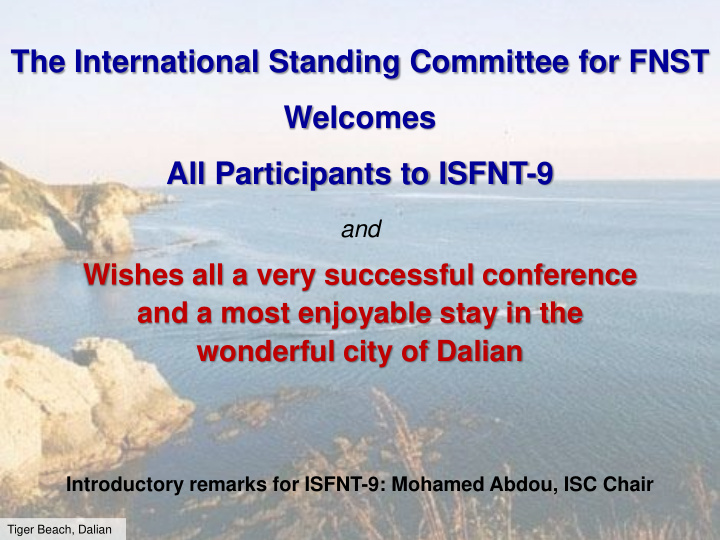



The International Standing Committee for FNST Welcomes All Participants to ISFNT-9 and Wishes all a very successful conference and a most enjoyable stay in the wonderful city of Dalian Introductory remarks for ISFNT-9: Mohamed Abdou, ISC Chair Tiger Beach, Dalian
The International Symposium on Fusion Nuclear Technology (ISFNT) series of conferences was conceived in the 1980’s with the following goals: – Foster interactions among scientists and engineers working on the many technical disciplines and the many multidisciplinary issues for Fusion Nuclear Science and Technology (FNST). – Enhance international collaboration. – Recognize FNST as a key pillar of fusion development.
Fusion Nuclear Science and Technology (FNST) Fusion Power & Fuel Cycle Technology FNST includes the scientific issues and technical disciplines as well as materials, engineering and development of fusion nuclear components: From the edge of Plasma to TF Coils: 1. Blanket Components (includ. FW) 2. Plasma Interactive and High Heat Flux Components (divertor, limiter, rf/PFC elements) 3. Vacuum Vessel & Shield Components Other Systems / Components affected by the Nuclear Environment: 4. Tritium Processing Systems 5. Remote Maintenance Components 6. Heat Transport and Power Conversion Systems 3
• structural mechanics • neutron/photon transport • radiation effects • neutron-material interactions • thermomechanics • plasma-surface interactions • chemistry • heat/mass transfer • radioactivity/decay heat • thermofluid physics and • safety analysis methods MHD and codes • thermal hydraulics • engineering scaling • tritium release, extraction, • failure modes/effects and RAMI analysis methods inventory and control • design codes • tritium processing 4
R&D for Fusion Nuclear Science and Technology is a “Grand Challenge” not only because of the multi-function, multi-physics, multi-engineering requirements and issues but also because of the complex and unique thermo-magneto-vacu-tritu-nuclear environment of fusion Neutrons (fluence, spectrum, spatial and temporal gradients) - Radiation Effects (at relevant temperatures, stresses, and loading) - Bulk Heating The kind of training - Tritium Production needed to perform - Activation and Decay Heat research and Heat Sources (magnitude, gradient) engineering within these - Bulk (from neutrons) highly constrained - Surface (from particles and radiation) fusion nuclear Particle Flux (energy, density, gradients) Magnetic Field (3-component with gradients) components takes many years of education and - Steady Field - Time-Varying Field experience. Mechanical Forces This is why ISFNT has - Normal (steady, cyclic) particularly encouraged - Off-Normal (pulsed) the participation of Thermal/ Chemical/ Mechanical/ Electrical/ young scientists and Magnetic/ Nuclear I nteractions and established an award for Synergistic Effects this purpose. - Combined environmental loading conditions - I nteractions among physical elements of components 5
ISFNT-9 follows 8 highly successful ISFNTs held once every 2-3 years and rotating among geographical regions of the world ISFNT-1 Tokyo, Japan April, 1988 ISFNT-2 Karlsruhe, Germany June, 1991 ISFNT-3 Los Angeles, USA June, 1994 ISFNT-4 Tokyo, Japan April, 1997 ISFNT-5 Rome, Italy September, 1999 ISFNT-6 San Diego, USA April, 2002 ISFNT-7 Tokyo, Japan May, 2005 ISFNT-8 Heidelberg, Germany October, 2007 ISFNT-9 Dalian, China October, 2009
The symposium focuses on all technical aspects of fusion nuclear science and technology (FNST) and related disciplines.. The conference includes invited and contributed papers organized around the following topics: 1. First wall technology and high heat flux components 2. Blanket technology 3. Fuel cycle and tritium processing 4. Material engineering for FNST 5. Vacuum vessel 6. Nuclear system design and reactor studies 7. Safety issues and waste management 8. Models and experiments for FNST 9. Remote handling and maintenance 10. Burning plasma control and operation 11. Inertial confinement fusion studies and technologies 12. FNST contributions to other fields of science and technology
More than 480 papers were submitted • About 90 oral presentations will be presented The technical program is strong and covers many current activities and issues in FNST and related areas of fusion research and development. The social program also looks exciting – please enjoy.
Thanks to ISC and IPC Thanks to the ISFNT-9 Chinese Organizers and Hosts: - General Chairs: Prof. Chuanhong Pan and Jiangang Li - Scientific Secretary, Prof. Yican Wu - Publication Chair: Prof. Kaiming Feng - Local Organizing Committee Chair: Prof. You-nian Wang (Full list of the many bright and hard-working young people who worked on LOC and the Scientific Secretariat will be acknowledged on Friday) Thanks to Guest Editors: Masato Akiba, Pattrick Calderoni, Kaiming Feng, Mohamed Sawan, Yican Wu, (timely and efficient reviews of submitted manuscripts for publication in FED) And the greatest appreciation is to the Conference Participants THANK YOU !
Recommend
More recommend